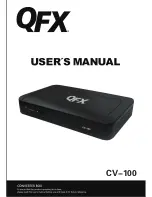
©
2009 Magnum Energy Inc
Page 16
2.3 DC Wiring
This section describes the inverter’s required DC wire sizes and the recommended disconnect/over-
current protection and how to make the DC connections to the inverter and the battery bank.
Refer to
fi
gure 2-8 when connecting the DC wires.
WARNING:
Even though DC voltage is “low voltage”, signi
fi
cant hazards may be pres-
ent, particularly from short circuits of the battery system.
CAUTION:
The inverter is NOT reverse polarity protected which means that if the neg-
ative and positive battery voltage is connected backwards to the inverter, the inverter
will likely be damaged. You should verify the correct voltage polarity using a voltmeter
BEFORE connecting the DC wires.
Info:
DO NOT connect the battery cables to the inverter until all wiring is complete
and the correct DC voltage and polarity has been veri
fi
ed.
CAUTION:
Before wiring the DC cables, review the safety information at the begin-
ning of this manual and the following to ensure a safe and long-lived system:
When the inverter is installed in a Photovoltaic System, the NEC requires that the
DC circuit conductors and overcurrent devices to the inverter be sized to carry not
less than 125 percent of the inverter’s maximum current rating.
The DC positive and negative cables connected to the inverter from the battery
bank should be tied together with wire ties or electrical tape approximately every
6 inches. This helps improves the surge capability and reduces the effects of induc-
tance, which improves the inverter waveform and reduces the wear of the inverter’s
fi
lter capacitors.
Crimped and sealed copper ring terminal lugs with a 5/16” hole should be used to
connect the DC wires to the inverter’s DC terminals.
The battery bank voltage MUST match the DC voltage required by the inverter (i.e.
24-volt battery bank for a 24-volt inverter) or the inverter may be damaged.
To ensure the maximum performance from the inverter, all connections from the bat-
tery bank to the inverter should be minimized, the exception is the DC overcurrent
disconnect in the positive line and a shunt in the negative line. Any other additional
connection will contribute to additional voltage drops and these extra connections
points may loosen during use.
All wiring to the battery terminals should be checked periodically (once a month)
for proper tightness. The torque requirement for the DC terminals is between 10
to 12 ft lbf (13.6 to 16.3 Nm). If you don’t have a torque wrench, ensure all DC
terminals are tight and cannot move.
Be aware that overtightening or misthreading the nuts on the DC terminals can
cause the bolts to strip and snap/break off.
Make sure cables have a smooth bend radius and do not become kinked. Place long
cable runs in conduit and follow existing wire runs where possible.
A brief spark or arc may occur when connecting the battery cables to the inverter
DC terminals; this is normal and due to the inverter’s internal capacitors being
charged.
Color code the DC cables/wires with colored tape or heat shrink tubing: RED for positive
(+); WHITE for negative (-); and GREEN for DC ground to avoid polarity problems.
•
•
•
•
•
•
•
•
•
•
Installation
















































